Abstract
In a coincidence timing task, Parkinsonian patients and a control group were instructed to synchronize a keypress with the onset of a visual signal which had been preceded by a regular train of warning signals. Although the Parkinsonian group had previously exhibited slower reactions in a conventional simple reaction-time task, they were able to generate predictive responses that fell as close to the target onset as the controls' but showed greater variability. In a second experiment, Parkinsonian patients and controls made saccadic eye movements to a visual target that stepped at regular intervals between two fixed locations. After a few trials all the subjects tended to make predictive saccades that were initiated before the target excursion. However, the Parkinsonian group were slower to develop this strategy and when they did their saccades became considerably more hypometric than those of the controls. Both groups were able to maintain predictive responding even when the visual target disappeared and responses were paced by a buzzer. We concluded that Parkinsonian patients are capable of initiating predictive responses of the eye and the hand, at least in some circumstances, but such responses tend to be inaccurate in execution. This, in turn, may dispose the Parkinsonian patient against predictive movement.
Full text
PDF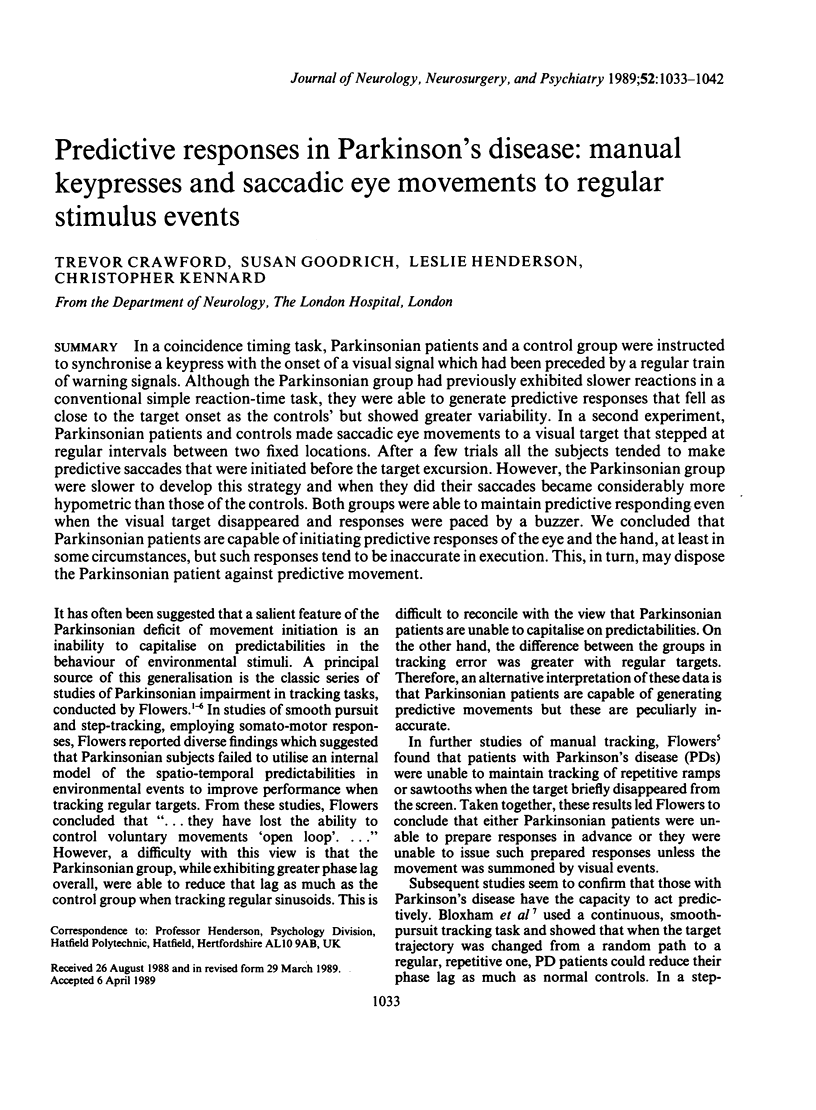
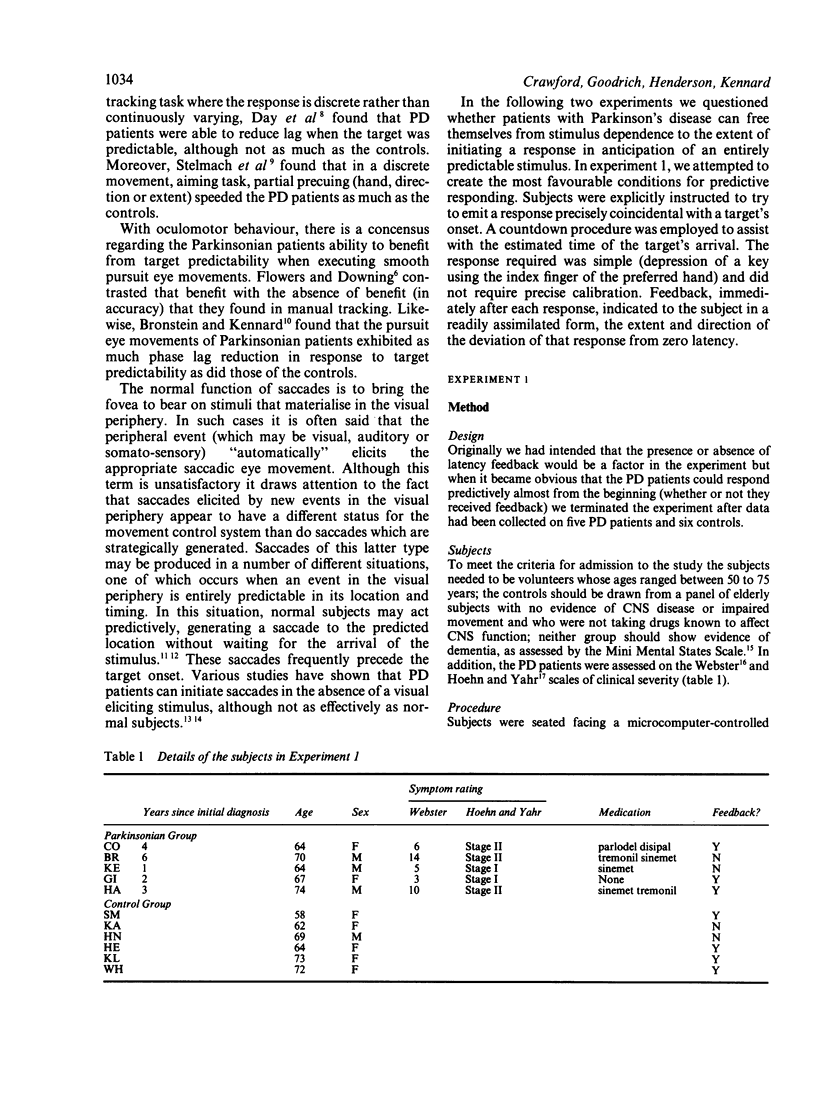

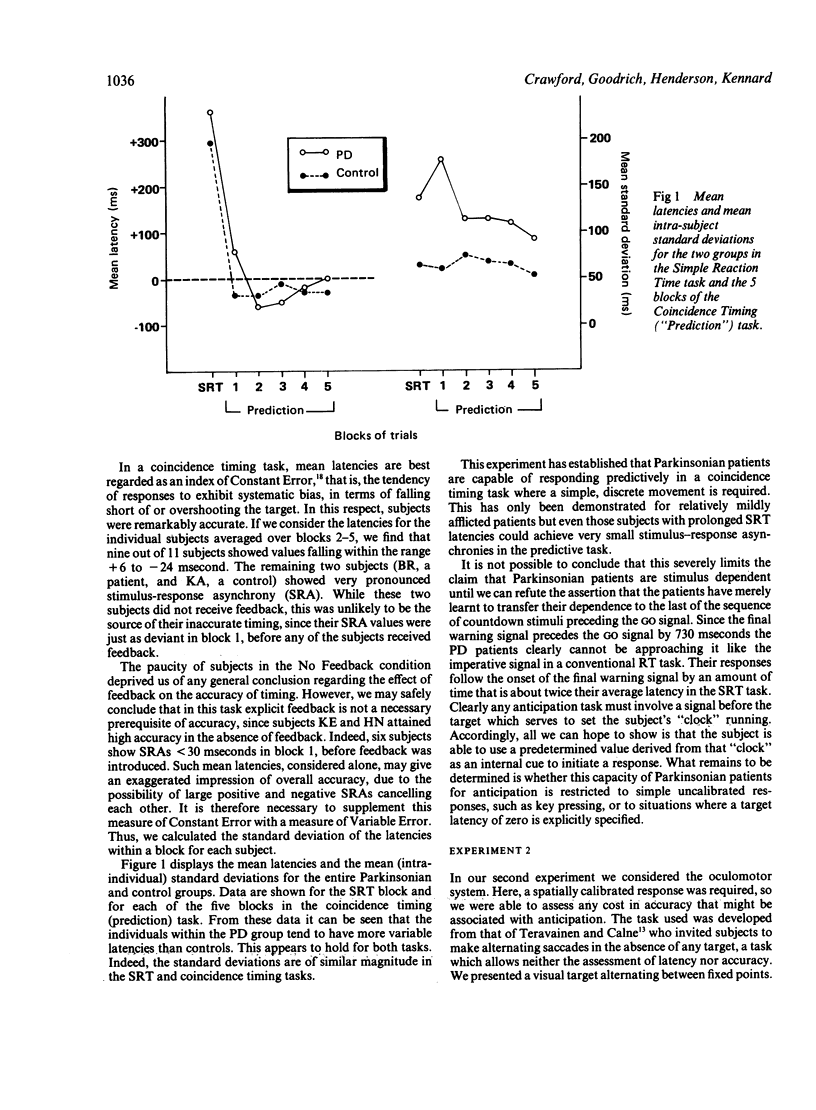

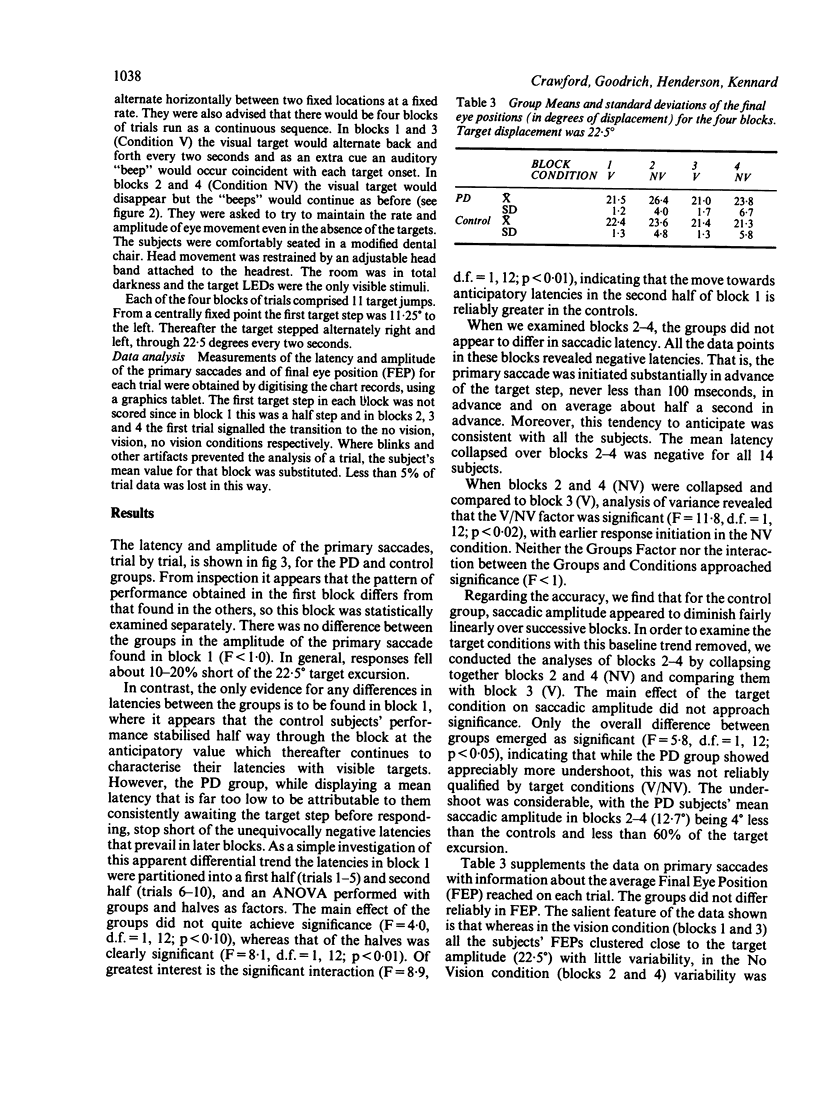
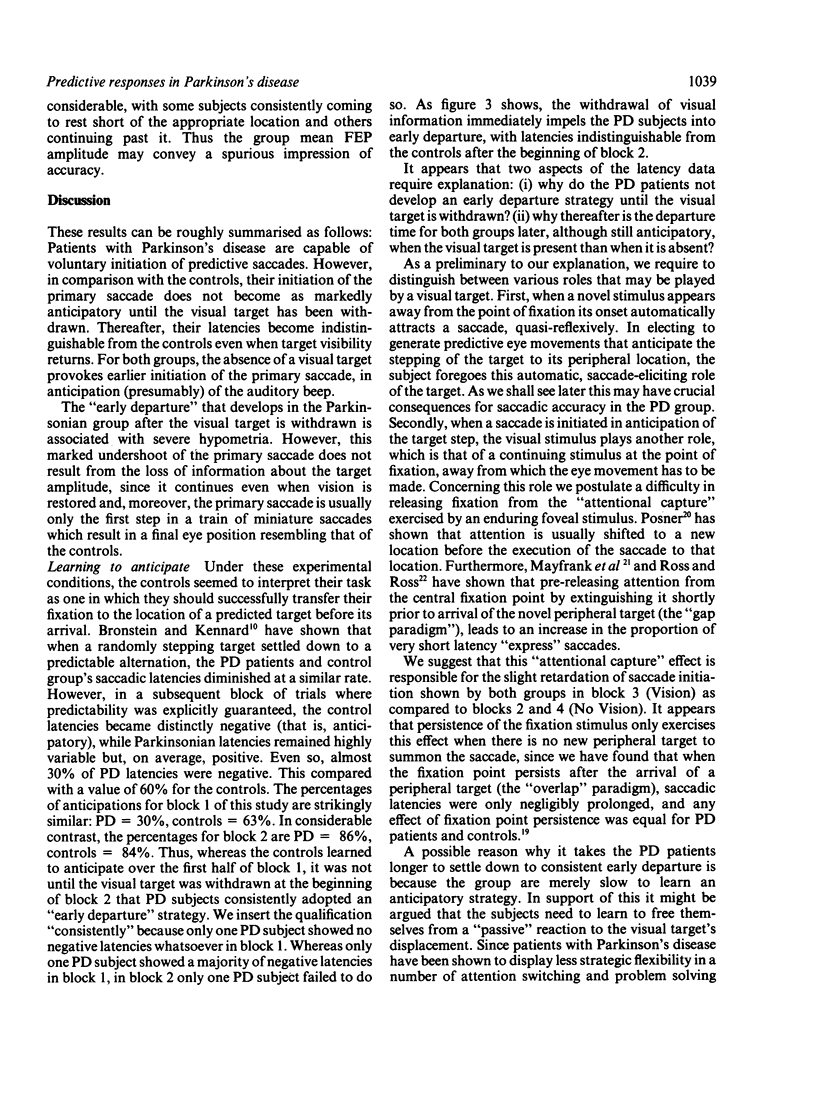
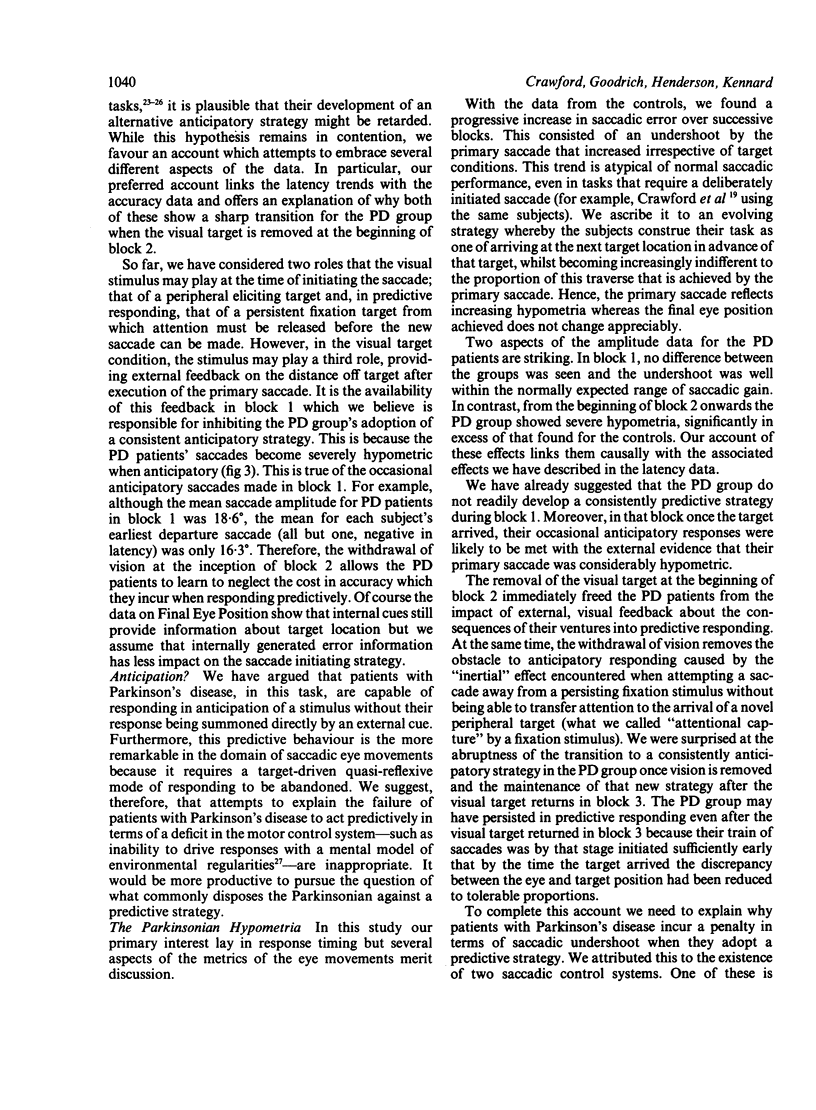

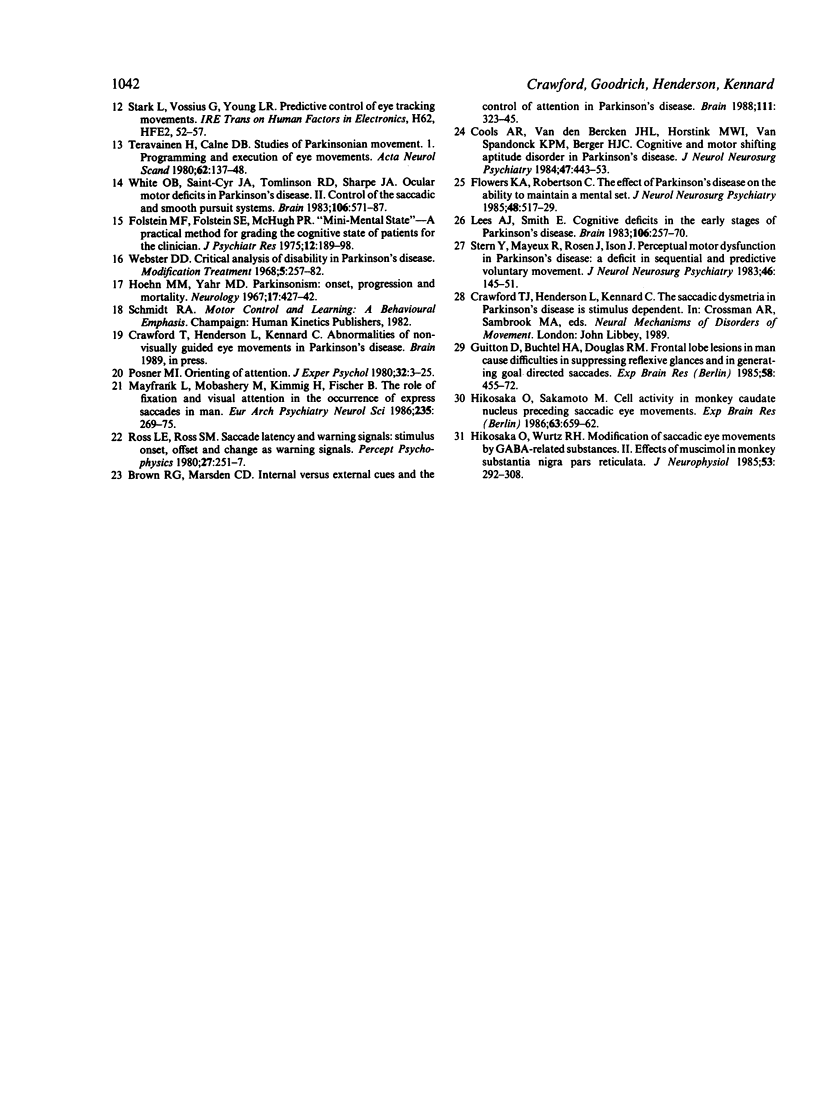
Selected References
These references are in PubMed. This may not be the complete list of references from this article.
- Bloxham C. A., Mindel T. A., Frith C. D. Initiation and execution of predictable and unpredictable movements in Parkinson's disease. Brain. 1984 Jun;107(Pt 2):371–384. doi: 10.1093/brain/107.2.371. [DOI] [PubMed] [Google Scholar]
- Bronstein A. M., Kennard C. Predictive ocular motor control in Parkinson's disease. Brain. 1985 Dec;108(Pt 4):925–940. doi: 10.1093/brain/108.4.925. [DOI] [PubMed] [Google Scholar]
- Brown R. G., Marsden C. D. Internal versus external cues and the control of attention in Parkinson's disease. Brain. 1988 Apr;111(Pt 2):323–345. doi: 10.1093/brain/111.2.323. [DOI] [PubMed] [Google Scholar]
- Cools A. R., van den Bercken J. H., Horstink M. W., van Spaendonck K. P., Berger H. J. Cognitive and motor shifting aptitude disorder in Parkinson's disease. J Neurol Neurosurg Psychiatry. 1984 May;47(5):443–453. doi: 10.1136/jnnp.47.5.443. [DOI] [PMC free article] [PubMed] [Google Scholar]
- Day B. L., Dick J. P., Marsden C. D. Patients with Parkinson's disease can employ a predictive motor strategy. J Neurol Neurosurg Psychiatry. 1984 Dec;47(12):1299–1306. doi: 10.1136/jnnp.47.12.1299. [DOI] [PMC free article] [PubMed] [Google Scholar]
- Flowers K. A., Downing A. C. Predictive control of eye movements in Parkinson disease. Ann Neurol. 1978 Jul;4(1):63–66. doi: 10.1002/ana.410040112. [DOI] [PubMed] [Google Scholar]
- Flowers K. A., Robertson C. The effect of Parkinson's disease on the ability to maintain a mental set. J Neurol Neurosurg Psychiatry. 1985 Jun;48(6):517–529. doi: 10.1136/jnnp.48.6.517. [DOI] [PMC free article] [PubMed] [Google Scholar]
- Flowers K. A. Visual "closed-loop" and "open-loop" characteristics of voluntary movement in patients with Parkinsonism and intention tremor. Brain. 1976 Jun;99(2):269–310. doi: 10.1093/brain/99.2.269. [DOI] [PubMed] [Google Scholar]
- Flowers K. Ballistic and corrective movements on an aiming task. Intention tremor and parkinsonian movement disorders compared. Neurology. 1975 May;25(5):413–421. doi: 10.1212/wnl.25.5.413. [DOI] [PubMed] [Google Scholar]
- Flowers K. Lack of prediction in the motor behaviour of Parkinsonism. Brain. 1978 Mar;101(1):35–52. doi: 10.1093/brain/101.1.35. [DOI] [PubMed] [Google Scholar]
- Flowers K. Some frequency response characteristics of Parkinsonism on pursuit tracking. Brain. 1978 Mar;101(1):19–34. doi: 10.1093/brain/101.1.19. [DOI] [PubMed] [Google Scholar]
- Folstein M. F., Folstein S. E., McHugh P. R. "Mini-mental state". A practical method for grading the cognitive state of patients for the clinician. J Psychiatr Res. 1975 Nov;12(3):189–198. doi: 10.1016/0022-3956(75)90026-6. [DOI] [PubMed] [Google Scholar]
- Guitton D., Buchtel H. A., Douglas R. M. Frontal lobe lesions in man cause difficulties in suppressing reflexive glances and in generating goal-directed saccades. Exp Brain Res. 1985;58(3):455–472. doi: 10.1007/BF00235863. [DOI] [PubMed] [Google Scholar]
- Hikosaka O., Sakamoto M. Cell activity in monkey caudate nucleus preceding saccadic eye movements. Exp Brain Res. 1986;63(3):659–662. doi: 10.1007/BF00237489. [DOI] [PubMed] [Google Scholar]
- Hikosaka O., Wurtz R. H. Modification of saccadic eye movements by GABA-related substances. II. Effects of muscimol in monkey substantia nigra pars reticulata. J Neurophysiol. 1985 Jan;53(1):292–308. doi: 10.1152/jn.1985.53.1.292. [DOI] [PubMed] [Google Scholar]
- Hoehn M. M., Yahr M. D. Parkinsonism: onset, progression and mortality. Neurology. 1967 May;17(5):427–442. doi: 10.1212/wnl.17.5.427. [DOI] [PubMed] [Google Scholar]
- Lees A. J., Smith E. Cognitive deficits in the early stages of Parkinson's disease. Brain. 1983 Jun;106(Pt 2):257–270. doi: 10.1093/brain/106.2.257. [DOI] [PubMed] [Google Scholar]
- Mayfrank L., Mobashery M., Kimmig H., Fischer B. The role of fixation and visual attention in the occurrence of express saccades in man. Eur Arch Psychiatry Neurol Sci. 1986;235(5):269–275. doi: 10.1007/BF00515913. [DOI] [PubMed] [Google Scholar]
- Posner M. I. Orienting of attention. Q J Exp Psychol. 1980 Feb;32(1):3–25. doi: 10.1080/00335558008248231. [DOI] [PubMed] [Google Scholar]
- Ross L. E., Ross S. M. Saccade latency and warning signals: stimulus onset, offset, and change as warning events. Percept Psychophys. 1980 Mar;27(3):251–257. doi: 10.3758/bf03204262. [DOI] [PubMed] [Google Scholar]
- Stelmach G. E., Worringham C. J., Strand E. A. Movement preparation in Parkinson's disease. The use of advance information. Brain. 1986 Dec;109(Pt 6):1179–1194. doi: 10.1093/brain/109.6.1179. [DOI] [PubMed] [Google Scholar]
- Stern Y., Mayeux R., Rosen J., Ilson J. Perceptual motor dysfunction in Parkinson's disease: a deficit in sequential and predictive voluntary movement. J Neurol Neurosurg Psychiatry. 1983 Feb;46(2):145–151. doi: 10.1136/jnnp.46.2.145. [DOI] [PMC free article] [PubMed] [Google Scholar]
- Teräväinen H., Calne D. B. Studies of parkinsonian movement: 1. Programming and execution of eye movements. Acta Neurol Scand. 1980 Sep;62(3):137–148. doi: 10.1111/j.1600-0404.1980.tb03015.x. [DOI] [PubMed] [Google Scholar]
- Webster D. D. Critical analysis of the disability in Parkinson's disease. Mod Treat. 1968 Mar;5(2):257–282. [PubMed] [Google Scholar]
- White O. B., Saint-Cyr J. A., Tomlinson R. D., Sharpe J. A. Ocular motor deficits in Parkinson's disease. II. Control of the saccadic and smooth pursuit systems. Brain. 1983 Sep;106(Pt 3):571–587. doi: 10.1093/brain/106.3.571. [DOI] [PubMed] [Google Scholar]


